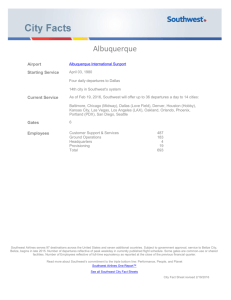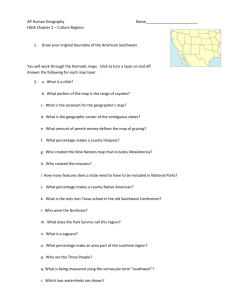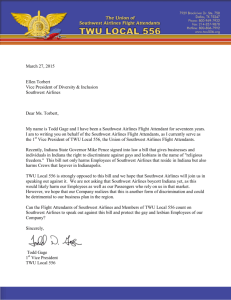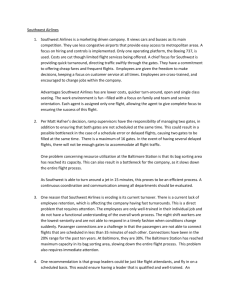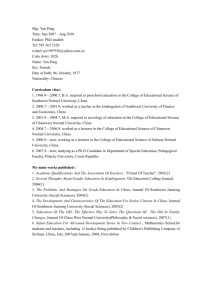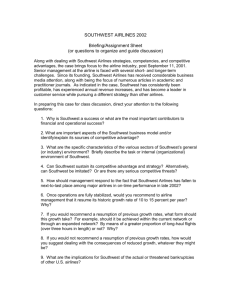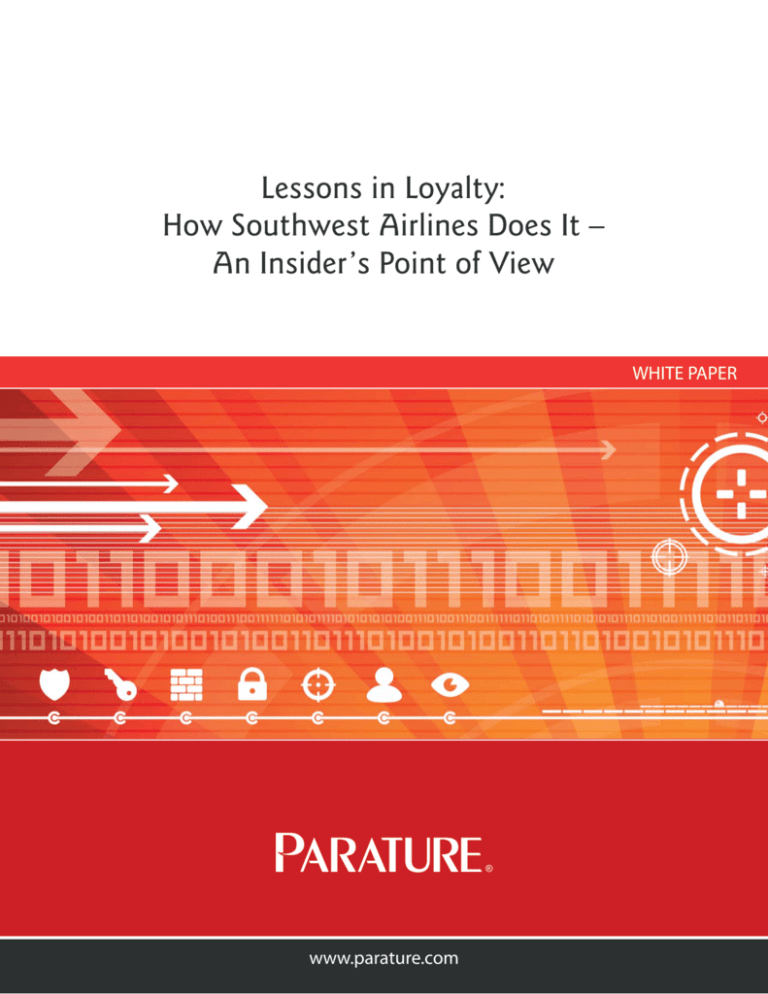
Lessons in Loyalty:
How Southwest Airlines Does It –
An Insider’s Point of View
WHITE PAPER
®
www.parature.com
Lessons in Loyalty: How Southwest Airlines Does It - An Insider’s Point of View
WHITE PAPER
Imagine making a one-time decision to place the fate of your entire company in the hands of your Customers. If your well-placed faith
in the good relationship with your Customers is right, you get to stay in business. If not, you’re history.
Such was the case for Southwest Airlines post-9/11. We began to get requests for refunds from Customers who had purchased tickets
but were now afraid to fly. Our competitors decided to allow the refund, but tack on a “refund penalty” to cover their cost and lost
revenue. Not Southwest. We put ourselves in our Customers’ shoes. We thought, “Why should we penalize people who had become
fearful of flying due to circumstances beyond their control?” So, we took a risk and decided to offer full refunds to anyone who asked
with no penalties. We were counting on our Customers not making a “bank run” refund request. Why? Because we had developed a
great relationship with our Customers and trusted they would have faith that we would get through the tough times following 9/11.
And, they proved us right. In fact, not only did many of them not ask for a refund, we were overwhelmed when many sent their tickets
in with notes saying “Southwest Airlines, take this ticket and keep it. I don’t want my money back…I just want you in business in five
years and today you need the money more than I do.”
Where does that kind of loyalty come from?
I was a leader at Southwest Airlines for fifteen years and can speak to the level of
attention Customer service gets within the company. We were taught that we were
in the Customer service industry; we just happened to fly airplanes. Customer
service was not just a mantra nor was it a flavor of the week. It was a mindset
established from the birth of the company; a living, breathing philosophy that
manifested itself in all facets of our business. It was our way of life, our credo, our
mantra; and Southwest Employees learned to ooze it from their pores. Customer
service resided in our mission statement, our meetings, and our celebrations. It
started at the beginning of every new Employee’s time with Southwest. The
Customer service principles that follow were learned during my time at Southwest.
We were taught that we
were in the Customer
service industry; we just
happened to fly
airplanes.
Hire for Attitude, Train for Skill
Just because an applicant claims to be good at Customer Service, don’t believe it. At Southwest, we didn’t care about an applicant’s
background; we believed if you had the right attitude we’d teach you how to deliver great Customer Service. We placed ads to attract
fun-loving, irreverent personalities because we knew that those were the folks who could have fun on the job and fun with our
Customers. “Work at a place where wearing pants is optional” was an ad showing a flight attendant holding a tray of drinks while
wearing shorts. Applicants were interviewed with a keen eye towards Customer service. “Tell us about a time when you defused a
difficult Customer situation with humor,” or “Tell us about a time you went above and beyond for a Customer,” were questions we
might ask in an interview. We figured that if you had a history of having done it, you were going to continue doing it. Our front line
Employees were encouraged to call us if they saw any applicant exhibiting rude behavior at the airport or on the plane as they flew in
for the interview. That person would be given a ride back to the airport to catch a flight home. Once, an applicant with a strong
Customer service background challenged me over me hiring a person with no Customer service experience rather than her. What she
didn’t know was that during the interview presentation, the other applicant, who happened to be a hairdresser, had everyone in
stitches with her stories about helping her Customers. The challenging applicant had no such stories; she simply spouted the theory of
®
Lessons in Loyalty: How Southwest Airlines Does It - An Insider’s Point of View
WHITE PAPER
good Customer service. Attracting and interviewing for the Customer friendly attitude is where it starts.
Teach Them from the Start
Once hired, the Employee was immediately immersed in Southwest’s Customer service culture. New Employees were challenged to a
scavenger hunt at our Headquarters where they learned all about our history, saw the ads produced over the years, learned about the
awards we’d won, etc. In new hire training they watched a video showing Customers from other airlines talking about why they were
no longer doing business with the airline. Personally, as a new Employee, it was distressing to hear the stories these Customers told on
the video of rude Employees addressing Customers who walked up with a simple question and being told, “Go to the end of the
line….it will be your turn when it will be your turn!” As a new hire I thought, “Well no wonder those folks left that airline…I would too,
given the rude behavior exhibited by the Employees!” At the end of the video the new Employees discovered that the Customers in
the video were talking about personal experiences they’d had with Southwest Airlines! Southwest had enlisted the help of these
“former” Customers to help teach the lesson about the importance of good Customer service. In fact, there was a section in the video
showing how many Customers it took to turn a profit…we were told that a mere five passengers per plane made the difference
between making a profit and losing money. It was a great way to instill the importance of Customer service from the onset.
VP of Customers
Southwest Airlines recognized early on that in order to keep the Customer service spirit alive and well it was necessary to have
someone at the highest levels oversee the entire initiative. Thus, Southwest was the first to create a position entitled “Vice President of
Customers.” For many years Colleen Barrett held the position. She understood that Customers always come first, and that in order to
have a Customer service mindset you cannot separate the importance of the internal Customer (Employees) from the external
Customers (passengers). If the internal Customer is happy, it will naturally flow to the external Customer in the form of good service. It
was due to her diligence, persistence and passion about Customer service that she was able to create and keep the Customer service
mindset alive and well over the years. The Spirit of the Southwest Customer service philosophy became legendary throughout the
industry. Competitors tried to emulate the programs, but few ever made it past first base. You cannot “dictate” that people be funny.
You cannot “measure” the fun. People either possess the Customer service personality or they don’t. Southwest was a leader in
recognizing that by creating this unique VP of Customers position, they could ensure the Customer stayed uppermost in the minds of
all Employees.
The Keys to the Kingdom
Employees at Southwest were empowered to “do the right thing” (versus doing what was right). Empowerment can be one of the most
powerful tools a company can utilize to ensure that Customers are taken care of when things don’t go as planned. To be comfortable
giving that right to your Employees, you must be confident in the new hire’s ability to make good decisions. You’ll only do that when
you’ve hired people with the right attitude and trained them in your Customer service philosophy.
With empowerment, however, comes the risk that your Employee may make a mistake. For example, one night at Hobby Airport the
last flight of the night had departed and a brand new Customer service agent was closing out the books. A frazzled man approached
the gate and, out of breath, asked the agent if he could get on the flight. The flight had left moments ago so there was really nothing
®
Lessons in Loyalty: How Southwest Airlines Does It - An Insider’s Point of View
WHITE PAPER
the agent could do. The distressed Customer began to cry and explained that his
daughter was undergoing a liver transplant in the next few hours and he simply had
The secret to empowering
to be with her, as he might never see her again. The new agent listened with
Employees is to give them
empathy, and then replied, “Just a moment, sir, let me see what I can do.” He picked
up the phone and chartered a private jet for this gentleman. Then he took the
the keys to the kingdom
gentleman over to the private terminal to ensure he made the flight. The next day
and let them know you
his boss called him into the office to explain that while he commended him for
trust them to use the keys
taking care of the Customer, he really should have had the Customer pay for the jet,
wisely.
not Southwest Airlines! The Supervisor was demonstrating the philosophy that was
key to keeping empowerment alive and well at Southwest. That philosophy taught
Employees that as long as their intent was to help the Customer, fellow coworker or
company, even though things might backfire, they would not be fired. How management handles the newly empowered Employee’s
mistake is paramount to whether they will continue making decisions or default to the rule book (“Sorry sir, there is nothing I can do.”).
And Employees, like Customers, talk. A wrong move on management’s part in reference to empowerment can demotivate not only
that Employee, but also others who hear the story.
The secret to empowering Employees is to give them the keys to the kingdom and let them know you trust them to use the keys
wisely. Give Employees the ground rules, but also give them the latitude to bend the rules. Empowerment is a powerful tool that can
make the Employees feel like owners of the company and, after all, who takes care of a company better than an owner? With
empowerment, your Employees will return positive results again and again. One of the best examples of this was what the flight
attendants did post-9/11.
It was a chaotic time for the airline industry. Things were changing almost hourly and Customers were facing new rules every time
they flew. Previously, passengers had to submit to an initial TSA security check prior to getting to their gate. The TSA decided one day
to add a secondary TSA check upon boarding the flight for randomly selected passengers. The reason this was more troubling on
Southwest is that we did not have assigned seats, thus the person who had gotten to the airport early to get an “A” boarding pass
(allowing them to board first and select the seat of their choice), if selected by the TSA for that secondary screening at the gate, ended
up boarding with those who had “C” boarding cards. By the time they boarded, many of the choice seats were taken and they ended
up in the dreaded middle seat. Needless to say, they were not happy. Our flight attendants seized the moment and began to save the
first row of the aircraft for those specific passengers. They did not ask anyone if they could do this, they simply saw the need and came
up with a solution. They knew they had the freedom to make this decision. Their intent was to help the Customer and they were right.
This is empowerment at its best.
We are Family
When you see your Customers through the eyes of friendship and family, you start to do things for them that you usually do only for
your family and friends. Specifically, at Southwest Airlines we sent our most frequent Customers a birthday card. One year, a Customer
called to let us know that we were the only one who remembered his birthday! The airport ticket agents were on a first name basis
with our most frequent fliers and knew the names of their children, spouses, etc. In fact, our Customers reciprocated with our agents.
One day a call came in from a Customer asking where a particular agent was. The Customer said he hadn’t seen her in a while and
®
Lessons in Loyalty: How Southwest Airlines Does It - An Insider’s Point of View
WHITE PAPER
wondered if she was okay. He was informed that in fact she’d been ill, but was recovering. That’s a great example of developing
relationships with your Customers.
Often we would invite our Customers to participate in company events. Halloween was one of the holidays that we celebrated in a big
way. Every department competed by having a theme and some even put on shows. As the District Marketing Manager in Houston, I
invited several of our good Customers to fly to Dallas with us that day with the stipulation that they must dress up. They all came,
dressed in pajamas and had a fabulous time. By the time we left Dallas, they were raving about the culture, the fun and the great time
they had.
Check Your Ego at the Door
Southwest Airlines understood and practiced the principles of Servant Leadership long before that concept was popular. In line with
initially hiring the right attitude, when looking for leaders, we sought humble, altruistic, compassionate mindsets that could be tough
when needed. People skills were a must. These leaders walked the talk by spending time with the front line Employees, maintaining
open door policies and empowering their people. When it came to Customer Service, these leaders exemplified it first and foremost
with their internal Customers. They were hired and promoted because they took their business seriously, but not themselves.
The first time I met Herb Kelleher I was a new Employee attending a Marketing Department function. I noticed a crowd gathered
around the bar. When I went up to get a drink, to my surprise, the bartender was Herb Kelleher! Over the years I saw Herb
demonstrate this fun-loving camaraderie with many Employee groups. Good leaders today must possess good people skills. And, you
can’t fake caring. Your Employees and Customers will see right through it.
Leaders should get to know their people. Southwest was one of the few companies where leaders could get fired by their teams. It
was paramount that leaders stayed in touch with their teams to ensure teams received the support needed. The upper management
of Southwest Airlines possessed one common trait…they did not have big egos. That wasn’t to say they couldn’t hold their own in a
battle, but ultimately, their true passion was about helping their people be the best they could be.
At Southwest, we used to have a rules and regulations policy book, which, over time, grew to several hundred pages. Once, a new VP of
HR challenged each department to take their section and pare their section significantly. “You see,” she said, “when you put too many
rules in place your leaders quit thinking for themselves. They will default to the book, and that does no one any good. You’ve got to
allow them to use common sense when making their decisions. This overinflated book takes away their ability to use their common
sense.” At the end of the project we ended up with a 79-page book entitled “Guidelines for Leaders.” It’s still in place today.
Fun, Fun, Fun
At Southwest, we knew how to have fun and having fun was a strategy we employed. We felt if people were having fun on the job,
they would be more apt to come to work, have a great attitude and deliver great Customer service. When things got stressful at the
airport due to bad weather causing delays, we played gate games with our Customers to relieve that stress. When the gate agent
would announce to the Customers sitting in the boarding area that we were giving a $25 off coupon good for their next flight if they
had a hole in their sock, people took off their shoes and held up their foot to let us judge who had the biggest hole. One woman even
®
Lessons in Loyalty: How Southwest Airlines Does It - An Insider’s Point of View
WHITE PAPER
ran her panty hose to win! It was a lot of fun and took the Customers’ minds off the delayed flight.
Anyone who has ever flown Southwest has probably been exposed to the fun attitude of our pilots and flight attendants. One day I
watched a pilot walk up the jetway into the plane with a briefcase. Sticking up outside the briefcase was a book entitled Learn How to
Fly, or the flight attendants would announce that there was an individual on the flight who was celebrating his 95th birthday and
asked the entire cabin to sing Happy Birthday. At the end of the song, she would announce that the pilot was very grateful for their
attention. They might sing a song, tell a joke or tell people “Smoking is not allowed on this aircraft. Anyone caught smoking will be
escorted outside to watch the movie “Gone with the Wind.”
One year Southwest was actually challenged by the FAA to change our funny
onboard announcements as they felt people were not taking the safety messages
seriously. We argued back that to the contrary, we felt because we infused humor
into the typically rote, boring announcements, that people listened more. The FAA
finally agreed and dropped the issue.
Fun was a strategy we implemented from the minute we met and interviewed a
prospective Employee. For example, one of the questions asked of me in my
interview with Southwest was “When was the last time you laughed at yourself?” We
wanted people who would take their jobs seriously, but not themselves.
Fun was a strategy we
implemented from the
minute we met and
interviewed a
prospective Employee.
As managers, we were expected to spend a day each quarter in a department other than our own. I once chose to spend it at
Intercontinental Airport in Houston. I spent the day learning how to load the bags into the belly of the plane. At the end of my shift
the supervisor asked me if there was anything else I wanted to learn. I responded that I’d always wanted to flag in a plane. “Okay,” he
replied, “In fact we have one coming in right now. I’ll let you flag him in.” So, I put on a safety vest and headphones, grabbed two
wands and listened as he gave me quick instructions about the signals I’d be using. I was so excited! He then said “You know, you’re a
little short, so you need to stand on top of the tug so they can see you.” I agreed and the plane then rounded the corner and began to
approach. “Okay,” the agent said, do the signals I taught you. So, I began to wave the wands around when he said, “Do the last signal.”
Much to my horror, as I made a complete circle with the wand, the entire aircraft did a 360 degree turn on the tarmac! What I didn’t
know was that the supervisor had called the captain and said, “We have a new Employee here and I’d like to play a joke on her.” The
captain in turn announced to the passengers what was happening. When the plane finally pulled up to the gate and the passengers
deplaned, they were all waving at me and grinning. Now, if I’d been the type of person who couldn’t laugh at myself, this type of joke
would have fallen flat. As it was, it was a great example of how creative and fun the Employees at Southwest are.
Keeping Customers at the Forefront of Employees’ Minds
Southwest Airlines has probably one of the best strategies for reward and recognition of Employees, and one year we decided to
include our Customers in the fun.
We created a dollar bill with Herb Kelleher’s picture in the center and sent these Herb Bucks to our most frequent fliers, asking that if
they saw a Southwest Employee going above and beyond, they give them an Herb Buck. At the end of the program the Employees
®
Lessons in Loyalty: How Southwest Airlines Does It - An Insider’s Point of View
WHITE PAPER
would be able to purchase items from a catalog with the Herb Bucks. Surprisingly, the program was so popular that within weeks our
Customers were calling asking for more Herb Bucks. They were having a great time, and it was a great way to tie our Customers into
our recognition program.
Customers often were featured in our onboard magazine, “Spirit,” such as the lady who attended law school in Lubbock and flew back
and forth twice a week on Southwest to attend class. We featured Chuy’s Restaurant when they announced that they only opened
new restaurants in cities served by Southwest due to our low fares.
To remind us to consider the Customer, we created the MOM committee to review operational failures. The rule of thumb was if your
Mom had been on board, would you be happy with the way she was treated? We also kept an empty chair in marketing meetings to
remind us to consider the Customer.
Frequently, Employees were given $25 coupons and asked to recognize any Customer doing something nice. One scenario oft
repeated was a young mother and child boarding late. Because they were the last to board, many times there were no seats together.
The flight attendant would make an announcement asking if any passenger would be willing to move so the mother and child could
sit together. It never failed that some chivalrous soul volunteered. The flight attendant would then seek them out during the flight and
thank them for their kind deed by giving them a $25 coupon good towards their next flight. They were always pleasantly surprised.
For many years our paychecks had the message “Provided by our Customers” to remind the Employees of the Customers’ importance.
Anytime the words Customer or Employee were written, they were always capitalized to stress the importance of both.
These Customer service principles – Hire for attitude, train for skill, Teach them from
the start, VP of Customers, Keys to the kingdom, We are family, Check your ego at the
door, Fun, fun, fun and Keeping Customers at the Forefront of Employees’ minds –
are the tenets that not only make Southwest so successful, but that also keep
Southwest at the forefront of a very difficult industry. And, these Customer service
principles are generic enough that most companies can implement them. It’s not
rocket science, rather it’s common sense. The Golden Rule…putting yourself in
other’s shoes, being nice…seemingly simple concepts that smart companies like
Southwest realize keeps them at the top of their game.
It’s not rocket science,
rather it’s common
sense.
®
Lessons in Loyalty: How Southwest Airlines Does It - An Insider’s Point of View
WHITE PAPER
HEADQUARTERS
8000 Towers Crescent Drive
Suite 800
Vienna, VA 22182 USA
Phone: 703.564.7758
Fax: 703.564.7757
CALIFORNIA OFFICE
425 Market Street
Suite 2278
San Francisco, CA 94105 USA
Phone: 415. 593.7920
Fax: 415.593.7919
www.parature.com
ABOUT LORRAINE GRUBBS
Lorraine is the president of Lessons in Loyalty, a company specializing in helping
organizations create cultures where employees come to work because they
want to, not because they have to, recognizing that happy employees create
loyal customers. Lorraine delivers keynote speeches to organizations on her
recently published book, Lessons in Loyalty, which outlines the principles utilized
by Southwest Airlines to create one of the most productive and successful
cultures. This message is quickly gaining momentum in the business
community as a basis for companies who want to know how Southwest Airlines
and other companies do it. In addition, her book has now been published in four
countries.
As a HR consultant, Lorraine utilized the principles of the book to enhance the
culture and create a better bottom line in her two year role as Vice President of
Human Resources position at Pinnacle Airlines in Memphis.
Over a 15 year period at Southwest Airlines, Lorraine grew her way from District
Marketing Manager, to Manager of the University for People, to the company's
Director of Employment, tasked with "hiring Warrior Spirits". Her track record
includes her ability to achieve optimal results in times of chaos, high stress,
change and reorganization.
ABOUT PARATURE
Parature enables organizations to better serve, support, engage with and retain
their customers via the Web. Industry-leading, on-demand Parature Customer
Service™ software provides customer service organizations with a
comprehensive, multi-channel way to meet the growing expectations of their
customers. With more than 10 years experience, Parature serves organizations in
a wide variety of industries worldwide and helps support more than 16 million
end users. Parature is among Inc. Magazine's Top 100 Fastest Growing Private
Software Companies and is the recipient of numerous product, technology, and
leadership awards. Today, the Parature name is synonymous with innovation and
value in Web-based customer service software, strategies and best practices.
Parature is headquartered in Vienna, Virginia with offices in San Francisco and
the U.K. For more information, visit www.parature.com or follow @Parature on
Twitter.
©2010 Parature, Inc. All rights reserved. Parature and the Parature logo are registered trademarks of Parature, Inc.
All other trademarks are the property of their respective owners.
v05/10
®


